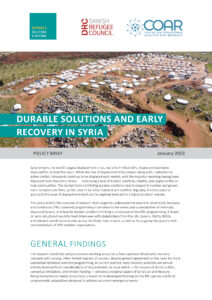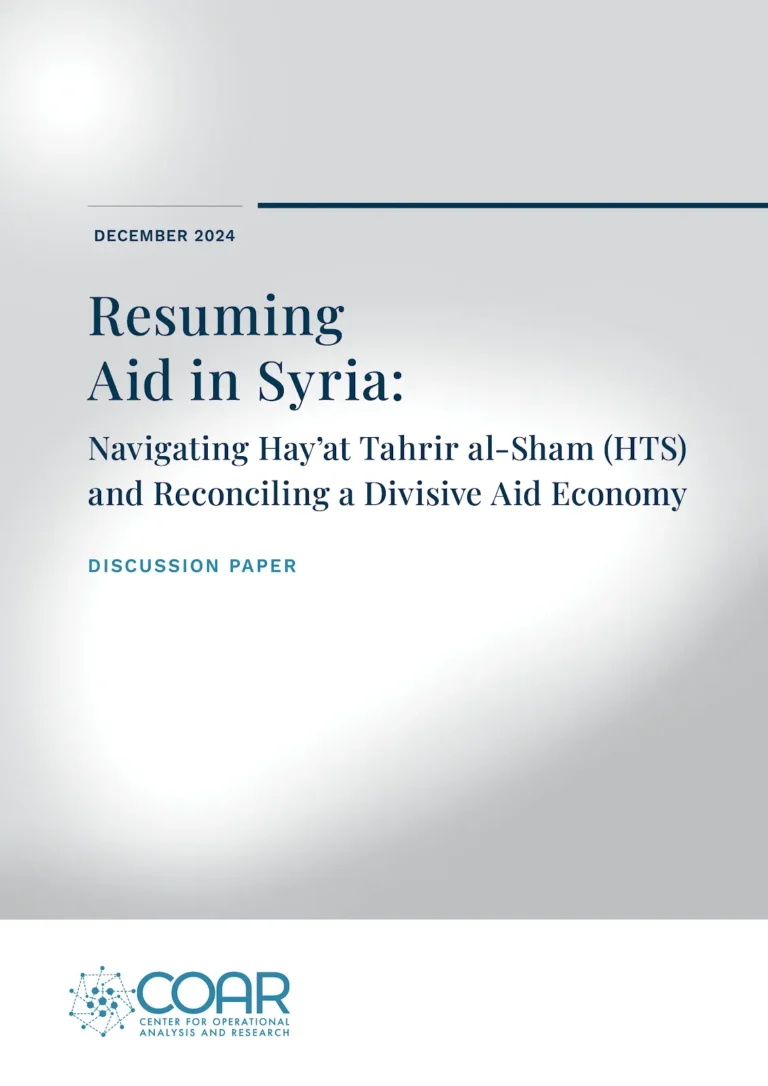Syria remains the world’s largest displacement crisis, out of 6.9 million IDPs 78 percent have been displaced for at least five years. While the rate of displacement has slowed along with a reduction in active conflict, thousands continue to be displaced each month, with the majority reporting having been displaced more than three times — evidencing a lack of durable solutions, stability, and opportunities in host communities. The myriad factors inhibiting durable solutions have increased in number and grown more complex over time, as the crisis in Syria has matured and ossified. Arguably, it is necessary to approach the issue of displacement both on the regional level and in a highly localised manner.
This policy brief is the outcome of research that sought to understand the extent to which Early Recovery and Livelihoods (ERL)-oriented programming is sensitive to the needs and vulnerabilities of internally displaced Syrians, and how far durable solutions thinking is incorporated into ERL programming. It draws on semi-structured key-informant interviews with stakeholders from the UN, donors, INGOs, NGOs, and relevant coordination bodies across the three hubs in Syria, as well as focus group discussions with representatives of DSP member organisations.

General Findings
The research found that aid practitioners working across Syria have operationalised early recovery concepts with varying, often limited degrees of success, despite general agreement on the need for more substantial resilience-oriented programming. In current practice, early recovery activities are almost entirely divorced from considerations of displacement, an issue which — for reasons of donor politics, contextual limitations, and limited funding — remains a marginal aspect of Syria’s aid architecture. Rising humanitarian needs across Syria prevent more developed thinking on the ERL agenda and force programmatic adaptations designed to address recurrent emergency needs.
Although displacement status is almost never used as an explicit criterion for beneficiary targeting or as a factor in programme design or within donors’ theories of change, displacement camps draw considerable political attention and consume commensurate resources, especially in northeast and northwest Syria, thus impeding the transition toward ERL. In addition, respondents emphasised that political, compliance, and practical limitations on dealing with local authorities in all parts of Syria are among the biggest barriers to more comprehensive work in early recovery, and therefore to promoting pathways to durable solutions for IDPs.
Nonetheless, opportunity exists inasmuch as early recovery objectives and displacement concerns are inherently interlinked. Indeed, prioritising durable solutions for Syria’s significant camp populations and other IDPs is an important step that may maximise value for money and facilitate more substantial progress toward early recovery objectives, including the transition beyond repeated cycles of emergency humanitarian support and reducing host-IDP tensions amid rising baseline needs. Syria remains locked in a frozen conflict, with little to no hope for a political breakthrough of the kind that may be needed for return across conflict lines in the foreseeable future. It is therefore important that aid practitioners emphasise the strategic utility of smaller steps toward durable solutions, rather than focusing exclusively on long-term outcomes that may remain out of reach for the foreseeable future.
Hub-Specific Findings
Government of Syria-Controlled Areas
Respondents interviewed for this research almost universally felt that donor red lines regarding working in government-held Syria are too unclear and prevent activities that donors and implementers alike view as being within the spirit and letter of current ERL thinking. Unclear red lines are a particular challenge in matters related to capacity building and engagement with local authorities, with KIs noting that refusal to engage in capacity building of state employees therefore jeopardises the potential of ER to strengthen existing service provision.
Return to government-held areas is not presently feasible for many displaced Syrians. This reality need not prevent aid actors from supporting those populations in living more dignified lives in the interim. A key challenge for offering support to IDPs is the legal aid ban instituted by the Government of Syria, which restricts the provision of legal counselling — a necessity for navigating HLP, civil status, and other bureaucratic and legal pitfalls that impede return. Equally considerable barriers exist with respect to access and permissions, in part due to the reality that the Government of Syria is unlikely to facilitate the en-masse return of refugees or IDPs now in other zones of control. In some sense, government areas are the wellspring of Syria’s internal displacement challenge, and durable solutions pathways should begin to countenance outcomes for these populations.
Northeast Syria
Host-IDP tensions are a pervasive “do no harm” risk, and competition over access to essential services is a critical driver of this risk, as is the perception that IDPs are favoured for humanitarian assistance. Indeed, donors’ political priorities have driven an outsized emphasis on programming within northeast Syria’s camps, to the exclusion of surrounding localities and the home communities of camp residents. This risks inflaming social tensions, reducing value-for-money through emphasis on emergency humanitarian activities, and putting ERL objectives such as long-term community resilience further out of reach.
Social and practical impediments constitute important barriers to near- and long-term integration pathways in northeast Syria. IDPs reportedly favour temporary displacement solutions in closer proximity to government-held territories due to uncertainty over political or social barriers to integration in communities deeper within Autonomous Administration of North and East Syria-held territory, while no reliable mechanism exists for brokering return to Government of Syria areas.
Northwest Syria
In Idleb governorate, Hay’at Tahrir al-Sham’s (HTS) designation as a terrorist group leads to compliance, political, and due diligence barriers for INGOs, limiting the extent to which they can implement early recovery programming. KIs also note resistance from (Western) donors to provide funding for longer-term shelter construction, with funding instead going towards the replacement of tents. KIs report that only Syrian NGOs, with Arab or Gulf backing, have projects to establish more durable shelter for IDPs.
KIs suggest that governing authorities in northwest Syria have made little progress in thinking about early recovery and, like the donor-funded aid response, have remained focused on responding to emergency humanitarian needs. As return of IDPs to their area or origin or resettlement elsewhere in the country are unviable and resettlement abroad is politically unlikely, integration provides the only viable pathway to some sort of durable solution for displaced populations. Social cohesion and integration elements in programming are needed to alleviate possible host-IDP tensions.
Recommendations
Recognise that early recovery and durable solutions objectives are intertwined. The shortcomings of current ERL activities put durable solutions further out of reach. Likewise, the failure to realise durable solutions saps time, attention, and funding from early recovery action and reduces communities’ resilience. Aid actors should promote efforts to realise durable solutions as a necessary condition for minimising displacement-related frictions and ensuring a transition to long-term programming.
Durable solutions thinking should not be reduced to issues of return to communities of origin. In some areas and in some individual cases, return is feasible, but in many others, it is unlikely in the foreseeable future. Activities that promote durable solutions might include (ERL) support for IDPs in their place of displacement and support to host communities in a manner consistent with their own desires and agency.
Donor agencies must more clearly articulate their desired outcomes with respect to ERL, at least for the purposes of project design and related activities, if they want partners to deliver greater impact amid rising needs.
Implementing partners should provide clearer language concerning aspects of project design that require engagement with local authorities. For example, some donors find it beneficial to stipulate the type of actor, distinguishing between line ministries and local authorities, while it may also prove useful to distinguish among modalities of interaction, such as perfunctory coordination (e.g., for access and permit) and cooperation (e.g., heightened engagement in project design).
Support research and analysis toward a comprehensive overview of internal displacement. Current information, largely focused on service access or aid availability, and the intentions of the displaced, is inadequate to inform response-wide decision-making and priorities. This is an impediment to streamlined programming due to the limited communications and coordination between hubs. Prioritisation of activities for IDPs and refugees will remain challenging until aid practitioners begin to understand factors influencing realistic durable solution pathways, which must be informed by contextual analysis.
Advocate more clearly for realistic durable solutions in Syria. The conflation of durable solutions with refugee return blocks needed support — including ERL programming — for IDPs as well as their home communities or potential places of integration.
Mainstream durable solutions thinking, particularly in ERL programming. The general shift toward a needs-based response risks marginalising displaced populations, particularly as narrower targeting criteria are developed. If durable solutions pathways are to remain relevant, they must be approached as a key aspect of area-based programming that seeks to foster community resilience and overall stability.





